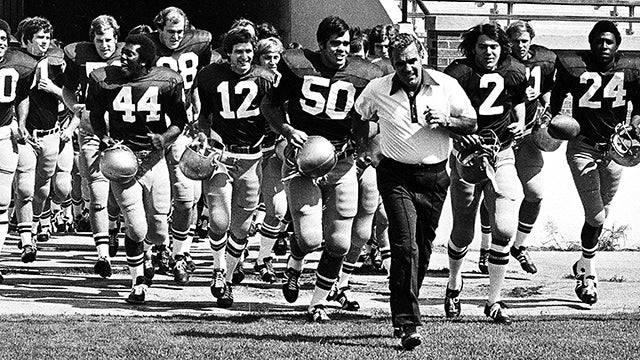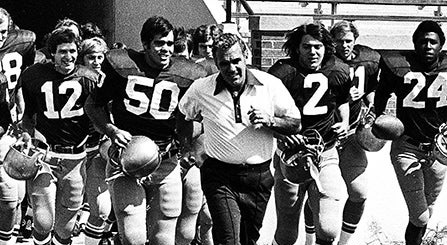
Spring football for Ara Parseghian and his coaching staff had several purposes. First, it was an excellent time to teach new ideas and football concepts to the younger players on the roster. At the same time, the coaches could evaluate their talent and find out how dedicated the players had been to their off-season conditioning program. Most importantly, perhaps, Ara and his staff could dedicate time to working on the basic and necessary techniques of football: blocking, tackling, ball security, throwing, and catching.
There were many excellent professors at Notre Dame during those years, but in my mind, there was no better teacher than Ara Parseghian. If there was a top ten list to describe Ara Parseghian, the teacher, it might look something like this:
1. Ara was positive. If he offered a criticism, he would pair it with a compliment.
2. Ara was confident. We believed in what Ara told us, individually and as a team. If we listened to him, we would improve as a player. If what he said was taken to heart, we would win as a team.
3. Ara was fair. If you were part of his team, you were part of Ara’s family. Ara gave every player a fair chance to win a position and show you could do it. If you had a bad day he would give you a pat on the back and say “let’s work harder tomorrow and get this right.”
4. Ara was realistic. Ara understood that players were going to make mistakes. He knew that. We all make mistakes on the football field and in life. He often talked about how players get beat on certain plays. But, what he was looking for were players who got right back up and fought again and again after making an error. To Ara, there was no shame in getting knocked down, but he did expect you to get up again.
5. Ara was a great communicator. Ara made his wishes known in a very clear manner. His message was simple and effective. His offense could be a run or a pass called at the line of scrimmage. It could go to the left or right according to a simple check off. The key player to make Ara’s plans work on the field was the quarterback, and we had a great one in Tommy Clements. Not only was Tommy Clements very gifted physically, he was better than all of us in understanding what Ara communicated and what Ara expected. I believe that if Ara had one game to win he would pick Tommy Clements to be his quarterback of all the great quarterbacks who ever played for him. Tommy Clements was articulate in communicating what Ara wanted. I was very lucky to be part of Ara’s program especially when Tommy Clements was at quarterback.
6. Ara was a strategist. Ara had a plan to win football games. It was as simple as that. He took great care in explaining what was need to reach our goals as a team. Ara spelled it out like this: if we run the ball and keep it away from the other team’s offense we will have a better chance to win. He was constantly harping on field position with our special teams. And it wasn’t all offense with Ara. He was a master at devising defenses to stop explosive offenses. Think of the plan he devised to “mirror” the Texas wishbone offense in the 1971 Cotton Bowl.
7. Ara was a “hands on” coach. Ara and his coaches were observant about every facet of a player’s life. He was not only concerned about our success on the football field, but also our academics. He also took notice of our social life, realizing that if we were mature in that area we would mature to be leaders on the football team. And don’t think Ara was only hands on with his starters. He wanted every player—from the prep team guys to the guys in the starting lineup—to mature and develop into productive citizens.
8. Ara was respectful. Ara respected us as players with one caveat: He expected us to work our tails off. If you did that, he respected your effort. Even if you were limited with physical talent, he wanted to see a player trying. Ara often said: “It takes no talent to give 100 percent. It takes no talent to be tough. It takes no talent to be on time. It takes no talent to have manners.” Ara wanted championship people more than he wanted championship players. Ara always took great will over great skill. Another thing he always said was “we have no breaking point” and he applied this to our character, integrity, and focus. Ara expected us to do the right thing even when nobody was watching.
9. Ara was patient. Ara always gave his players a second chance. But if you broke the rules again there were severe consequences for your actions. It could mean being thrown off the team or suspended for a period of time. We appreciated Ara’s patience with us to correct our mistakes. We also realized that when we were punished it was only after Ara had done so after great soul-searching on his part. We knew that it was Ara who made the final decision.
10. Ara was a man of faith. Ara held deep beliefs himself, and this was shown to us by the great faith he had in the people around him. He felt that each person had goodness in them, each person had deity in them that would come out in the form of positive response to life’s problems. He believed that every person had an innate goodness that allowed them to be kind, caring, and helpful to others. Love, as the song goes, is still the answer. Ara helped us recognize that life is about making a difference in others. He wanted us to do something each day for someone else who couldn’t repay us. That, he felt, was a good day.
How did these lessons of spring practice translate to our seasons and results on the field? Let me give you one example. The year was 1970, Thanksgiving weekend had just ended. The Irish played against Southern California and had a chance to have a 10-0 season, play in a bowl game against top-ranked Texas, and win the national championship. USC had a very disappointing season going into the Notre Dame game and had a record of 5-4-1. The game was played in a downpour of rain in the Los Angeles Memorial Coliseum. Notre Dame had eight turnovers, including two fumbles in their own territory. The Irish lost 38-28.
I was a freshman in 1970. I remember going to the ACC a few days after that game and getting a weight lifting workout in. The team managers couldn’t believe I was there. Many of the other players had already been released to head home for Christmas. I told the team managers that I was getting ready for spring ball. They thought I was nuts, but, there were a number of other freshmen who showed up that day: Gary Potempa, Dan Morrin, Tim Sullivan, and Tom Devine to name a few. Some were lifting, some were running, some were playing handball, and some were getting ready for the Bengal Bouts, a charity boxing tournament that is still held on campus to this day.
There were two open spots at offensive guard coming up for the 1971 season. All-American Larry DiNardo and Gary Kos, who was very good player, were both graduating. I was driven to take a shot at earning the left guard position. I had watched Larry DiNardo for the last three years and tried to mimic everything he did as an athlete. Larry went to the same high school I did in Brooklyn, New York: St. Francis Prep run by the Franciscan Brothers. The Brothers were very competitive and disciplined we had championship teams in many sports from football, baseball, basketball, bowling and kayak. I had a plan to get as big and strong as I could before spring ball and that is why I was in the weight room that day.
My main exercises were the squat, bench press and dead lift. In those days not many people lifted weights, but, it was beginning to catch on. I also spent the weeks and months before spring ball playing handball and running around the lakes behind the Dome. The managers and others kept asking me why I was training so hard. The mind set I had developed was I was going to start at guard, but, if I didn’t make the starting lineup I was going to be the strongest backup ever on Ara’s team. I would also point out that the USC guys were training hard and I wanted to be able to compete with them.
Freshman in those days couldn’t play in games, which I thought was great because we could adjust academically, socially, and athletically. I also had more time to work out. When spring practice started I was 6’1” and 243 pounds. It was clear I was bigger and stronger than the upperclassmen. However, the older guys had experience. It took a week or two of drills to prove I could play as well as they could.
Being aggressive and hungry on the field, I showed I could compete against our first team defense. In those days they were some of the best players in the country. My hard work paid off. By the third week of spring ball, Ara and the staff inserted me into the starting lineup at left guard where Larry DiNardo had been for the last three years. I was awarded the Hering Award as the top freshman offensive linemen. I was proud of my accomplishment, but, it meant nothing unless I was the starting left guard on opening day against Northwestern.
The fall came and I was the only sophomore to start on opening day of 1971. There were other sophomores that started during the season like David Casper and Mike Townsend, but, against Northwestern on opening day, I was the only sophomore starter. So for me spring ball was a very good thing. I think if you talk to other former Notre Dame players, they would agree with the assessment that spring practice provides a bevy of opportunities.
Mike Burgener, a defensive back on the 1966 national championship team is one of the players I asked about spring practice under Ara. He remembered that a lot of time in spring ball was spent working on fundamentals. Mike said that the team practiced tackling and keeping assignments during the spring before the ‘66 season. That defense turned out to be one of the greatest in college football history, only giving up 38 points all season. Burgener was also one of the first football players to lift weights at Notre Dame. Mike was a national class Olympic lifter in those days which was a very competitive sport. He still today teaches those lifts to young athletes. If you want to be a good weight lifter yourself, just follow Mike’s form.
Tim Sullivan was a three-year letterman at Notre Dame and a fiery competitor. Tim, a classmate and a teammate of mine on the 1973 team, was always in shape. He boxed in high school and was so good they wouldn’t let him box in the Bengal Bouts. He also wrestled in high school and was Iowa’s state champion in wrestling. So, his mentality was to be in shape all the time. Asked about Spring practice under Ara, Tim, remembers that he, like many of us, always had a headache from the contact in those practices. His thought today is that spring ball should be for instruction and not for contact. Too many players were getting concussions in those days and we didn’t even know it. We are now seeing the results of those days with player’s bodies so banged up that their shoulders, neck, hips and knees are shot. Tim believes that taking away the spring contact will help to save a player’s health in the future. Nowadays of course, there definitely is less contact both in spring practice and in practices throughout the season too.
Tim Sullivan now has a grandson that is competing for a linebacker position on this year’s Notre Dame team. Keep an eye out for Nolan Ziegler in 2023.
During the spring, Ara and his staff were always looking for players that were hungry to succeed, hungry to play for his program. Ara wanted his players to unleash themselves on the field with controlled rage.
All of these lessons from Ara lasted for a lifetime.
Pride, discipline and loyalty. Once we understood what Ara was trying to develop in us we recognized that faith in ourselves and becoming part of Ara’s family was his message. With Ara, educating ourselves in all facets of life became a priority. Ara wanted focused football players, but he expected us to be gentlemen off the field. Ara also hoped that his players, who were now part of his family, would be future leaders in their communities. Many of Ara’s players went on to become doctors, lawyers and businessmen and even judges.
Spring football was certainly a tough time of year. It was intense and it was hard. But by learning from Ara Parseghian we became champions, both on and off the field.
Frank Pomarico is a regular contributor to Fighting Irish Preview and was a three year starting Guard at ND from 1971-1973. He served as a Captain for the 1973 National Championship Team.

